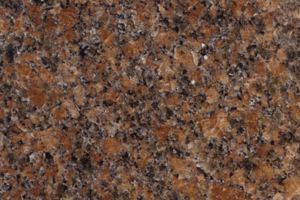Bohus granite
The Bohus granite (Swedish: Bohusgranit) is a type of granite that crops out along the Swedish West Coast in Bohuslän. In Norway the same granites are termed Iddefjord granite (Norwegian: Iddefjordsgranitt[1]), Østfold granite[1] and Halden granite.[1] A large quarrying industry has developed around the granites, mainly producing blocks. Large scale extraction begun in the 1840s and employment in the quarries peaked in the 1920s with over 7,000 people working in the industry. The rock is valued for its durability.[2] In the first half of the 20th century the transport of quarried Bohus granite was done with the aid of by the Lysekil Line.[3] In Norway Iddefjord granite has been a relatively common rock in architecture, further many of the renown statues of Frogner Park in Oslo are made of Iddefjord granite. Iddefjord granite is the official county rock of Østfold in Norway.[1]


Geology
Geologically the Bohus is a monzogranite, a subtype of granite. Besides the main minerals plagioclase, K-feldspar and quartz the Bohus granites contain lesser amounts of magnetite, apatite, zircon, titanite, garnet and monazite. In restricted areas alteration of the original rock has added prehnite, calcite and chlorite to the mineral assemblage. The texture of the granites varies from fine grained to coarse grained. The granites have pegmatite dykes associated to them. In terms of geochemistry the rocks have a narrow range of high silica contents (68–75 wt% SiO2) and are mildly peraluminous. The Bohus granites have also high uranium and thorium contents.[4]
The magma that formed the granites cooled about 920 million years ago after the end of the Sveconorwegian orogeny.[2][4] The intrusion of the Bohus granite was the last in a period of widespread intrusion of plutons in southwestern Sweden. The Bohus granites intruded and cooled in the brittle middle crust, thereafter being rapidly exhumed so that by the time of the formation of the Sub-Cambrian peneplain in the Late Neoproterozoic the rocks were at surface. Subsequently, the granites were buried in sediments and then intruded by NNW-SSE oriented basic dykes in the Permian.[4] In the Mesozoic the rocks were subject to significant weathering resulting in the formation an irregular grand-scale relief called the Sub-Mesozoic hilly peneplain. At a smaller scale the weathering is thought to have produced numerous small rock basins now seen near the coast.[5]
References
- Inge, Bryhni; Askheim, Svein. "Iddefjordsgranitt". Store Norske Leksikon (in Norwegian). Retrieved 9 October 2017.
- Schouenborg, Björn; Eliasson, Thomas (2015). The Swedish Bohus granite - a stone with a fascinating history. EGU General Assembly. Vienna, Austria. Bibcode:2015EGUGA..1714883S.
- Sten, Rolf (24 February 2004). "Snabbfakta LyJ, Lysekils Järnväg" (in Swedish). historikst.nu. Retrieved 30 April 2017.
- Eliasson, Thomas; Schöberg, Hans (1991). "U-Pb dating of the post-kinematic Sveconorwegian (Grenvillian) Bohus granite, SW Sweden: evidence of restitic zircon" (PDF). Precambrian Research. 51: 337–350.
- Johansson, Magnus; Migon, Piotr; Olvmo, Mats (2001). "Development of joint-controlled rock basins in Bohus granite, SW Sweden". Geomorphology. 40: 145–161.